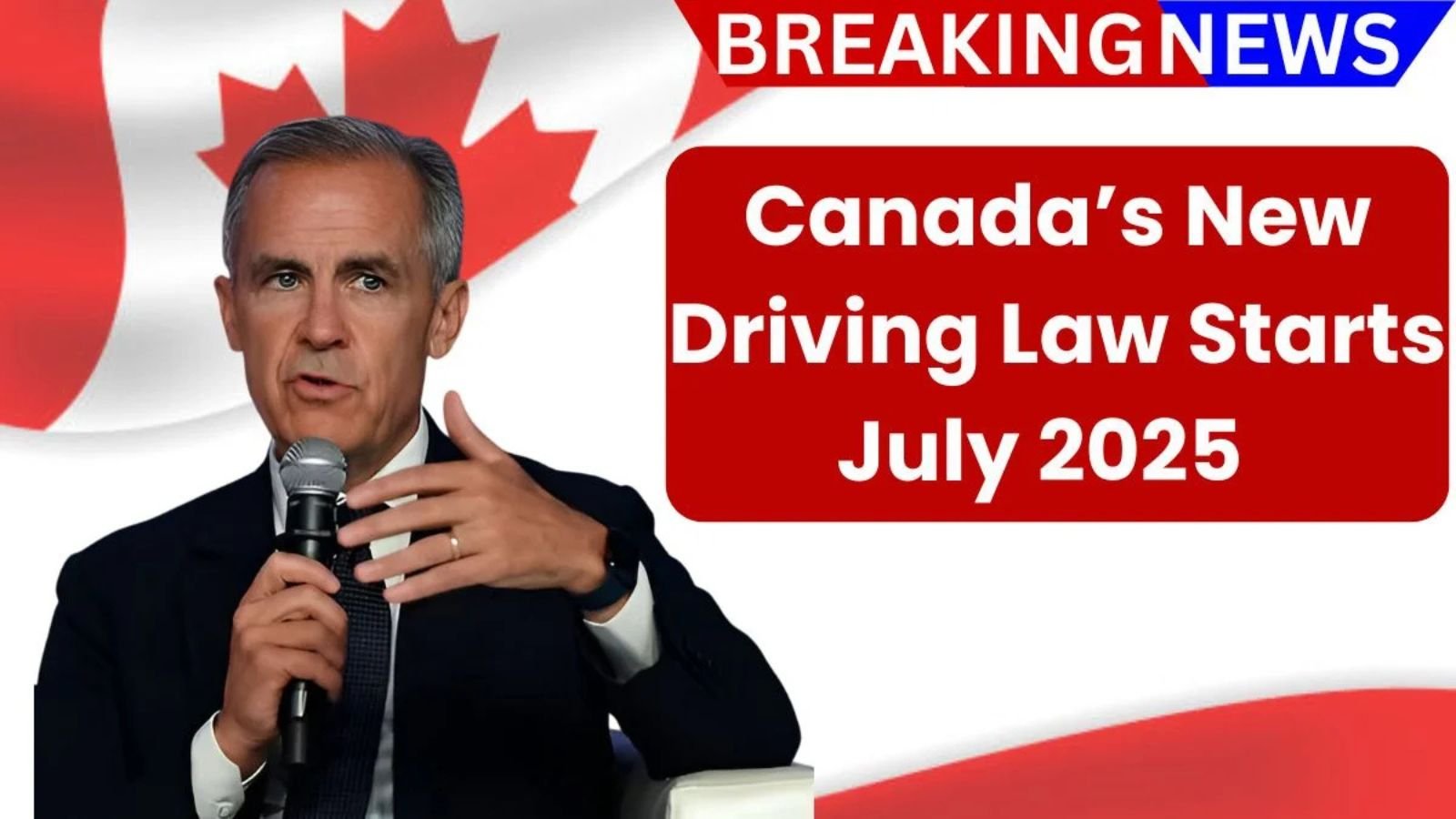Starting July 1, 2025, a sweeping overhaul is taking place across Canadian roads under Canada New Driving Law. This isn’t just a minor tweak to existing legislation — it’s a nationwide transformation that redefines how Canadians are expected to behave behind the wheel. Whether you’re cruising urban highways in Ontario or navigating quiet rural lanes in Alberta, the law applies uniformly. For all drivers — Canadian citizens, international license holders, or temporary residents — understanding and following these new rules isn’t optional; it’s essential.
The new legislation has been rolled out as part of a broader initiative to enhance road safety, reduce accidents, modernize outdated protocols, and increase accountability among motorists. With the number of road accidents linked to distracted driving and over-speeding reaching concerning levels, Canada’s New Driving Law is a firm, forward-looking response aimed at preserving lives and promoting responsible driving culture.
What’s Changing Under Canada’s New Driving Law in 2025?
Let’s explore the most significant revisions introduced under Canada’s New Driving Law, which is set to redefine road safety standards and driver responsibilities across the country.
1. A Crackdown on Distracted Driving – Beyond Just Phones
Distracted driving has long been a concern, but under Canada’s New Driving Law, the net has widened. No longer is it just about holding a mobile phone — the use of smartwatches, fitness trackers, and even hands-free devices will now be under strict scrutiny.
- What’s considered a violation?
- Answering calls or checking notifications on any wearable device
- Using voice assistants like Siri or Google Assistant when it distracts your focus
- Texting or browsing while in motion
- Adjusting music or apps while driving
Even mounting your phone to check directions will only be permissible if pre-set before the car starts moving. Violations may result in fines starting from CAD 700, along with demerit points, and repeat offenses may even lead to license suspension.
2. Speeding Penalties Increased by 40% Across the Nation
Speeding remains a top cause of traffic fatalities in Canada. Under Canada’s New Driving Law, penalties for over-speeding have been sharply increased:
- Across all provinces, fines have gone up by 40%
- Special focus areas include school zones and construction zones, where fines are doubled
- Speed monitoring systems will now use AI-driven radar to detect sudden acceleration or unusual driving behavior
This means you need to be extra alert, especially near schools and active work zones. Ignorance or habitual speeding can not only lead to financial penalties but may also impact your ability to renew insurance or avoid court summons.
3. Mandatory Training for New and Renewing Drivers
One of the most impactful changes under Canada’s New Driving Law is the compulsory training module introduced for all:
- New drivers must complete an updated safety module before acquiring a license
- Renewing drivers who haven’t completed a refresher course in over 10 years will need to take an online test or attend an awareness session
- Topics include distracted driving, impaired driving, speed management, and road-sharing etiquette
This initiative is targeted at instilling a stronger sense of road discipline among both first-time and seasoned drivers.
4. Private Parking Lot Infractions Now Enforceable
Until now, many infractions in private parking lots went unnoticed or unenforced. With Canada’s New Driving Law, this loophole has been closed:
- All provincial camera systems will now monitor private lots that are registered under the provincial traffic framework
- Violations like improper parking, reverse driving, or driving without seatbelts can trigger fines and warning notices
This change aims to standardize road safety expectations even in low-traffic areas, ensuring consistency everywhere.
How These New Driving Rules Will Affect You
Canada’s New Driving Law is not merely about punishing offenders — it’s a systemic reform meant to uniformly apply traffic laws across all provinces, making roads safer for everyone. Several provinces have already begun investing in real-time monitoring technologies to aid enforcement.
- Ontario has deployed intelligent license plate readers and auto-flagging tools
- British Columbia is using smart dashboards in police cruisers to recognize erratic behavior
- Alberta has activated radar-integrated roadside systems that scan vehicle speed and license data simultaneously
- Quebec has introduced AI-assisted automated ticketing in school zones
So whether you are heading to your 9-to-5 or enjoying a weekend drive, the way you drive will now be closely monitored and recorded.
Nationwide Awareness Campaigns to Educate Drivers
The government isn’t relying on enforcement alone. As part of Canada’s New Driving Law, a massive public awareness campaign is being rolled out:
- Billboard and radio ads highlighting new penalties and safe driving tips
- DMV notifications sent directly to registered license holders
- Mobile applications in some provinces allow drivers to check whether a specific behavior violates the new law
- Police and traffic officers have received specialized training to better recognize nuanced violations like partial inattentiveness or passive distracted driving
This is a proactive measure to make sure drivers are not caught off guard and are given every opportunity to understand and follow the law.
Who Must Comply with the New Law?
Canada’s New Driving Law applies to every individual driving within the country, including:
- Canadian citizens with provincial licenses
- Permanent residents and temporary workers
- Tourists and international students using foreign licenses
Non-compliance can result in:
- Fines
- License suspension
- Insurance complications
- Even criminal charges in case of accidents
Insurance companies have already begun adjusting their risk algorithms. Repeated violations could cause your insurance premiums to spike, claims to be denied, or policies to become non-renewable.
The Key Objectives of Canada’s New Driving Law
The reasons behind the sweeping reforms are both urgent and practical:
- To enhance safety for all passengers and pedestrians
- To reduce traffic-related fatalities and injuries
- To create uniform driving standards across all provinces and territories
- To instill discipline and awareness among the new generation of drivers
The government has made it clear: safety is not negotiable. It is a civic responsibility, not just a legal one.
A Checklist for Staying Compliant
To make your transition smoother under Canada’s New Driving Law, here’s a quick action checklist:
- ✅ Avoid using mobile phones, smartwatches, or any digital devices while driving
- ✅ Ensure all route maps are set before starting the car
- ✅ Enroll in a certified driver training or refresher module
- ✅ Keep your driver’s record clean to avoid insurance complications
- ✅ Stay updated with changes through the DMV apps or websites
- ✅ Watch out for speed zones, especially near schools and construction areas
What About Mobile Usage in Vehicles?
The most aggressive reform in Canada’s New Driving Law is centered on device usage:
- Making calls, texting, checking GPS, or adjusting music are now all violations unless done before driving or via voice command without compromising focus
- Smartwatches fall under the same category as phones
- Even brief glances at your screen can lead to fines — real-time cameras can now capture such behaviors
How Will This Impact Insurance?
Failing to comply with Canada’s New Driving Law may significantly dent your financial standing:
- Your vehicle insurance premiums could see a steep rise
- Multiple infractions may cause policy non-renewal
- Claims may be rejected due to a poor driving record
- Insurers are integrating provincial traffic data into risk profiles
Province-Wise Enforcement Focus
While the law applies nationwide, some provinces are taking an extra firm stance:
- Ontario: Stricter license suspension protocols
- Quebec: AI ticketing in school zones
- Alberta: Enhanced radar systems for speeding violations
- British Columbia: Emphasis on public outreach and education
Conclusion: Safety Over Speed
Canada’s New Driving Law isn’t about policing — it’s about protecting. In a time where multitasking has become the norm, the government is taking a bold step to ensure that driving remains a single-focused task. With a combination of high-tech surveillance, education, and strict penalties, the law encourages drivers to respect the road, the rules, and the lives around them.
This reform is not just legal; it’s cultural. It’s about reshaping how Canadians drive in the 21st century — more aware, more responsible, and far more mindful of safety.
FAQs About Canada’s New Driving Law
Q1. When does Canada’s New Driving Law come into effect?
A. The law takes effect on July 1, 2025, across all provinces and territories.
Q2. What’s the fine for distracted driving under the new law?
A. Fines start at CAD 700+, with possible demerit points and even license suspension.
Q3. Does the law apply to temporary residents and international license holders?
A. Yes, Canada’s New Driving Law is mandatory for everyone driving within Canada.
Q4. Are private parking lot infractions now considered violations?
A. Yes, violations in monitored private lots can now incur penalties under provincial systems.
Q5. Is training mandatory for new drivers under the 2025 law?
A. Yes, updated safety training modules are now compulsory for all new and some renewing drivers.
Some Important Link
| Telegram Group | Click Here |
| WhatsApp Group | Click Here |
| Home Page | Click Here |















